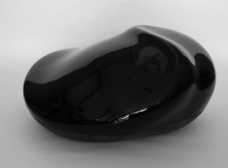Discussion
審査講評(3)
Comments on the Grand Prize Winner

いのち
Life
H22×W43×D42
2017
Ohnishi ───── We will have time for Q&A later, but for now, we would like each juror from the Final Assessment to comment on the prize winners. As I am also a member of the jury panel, I will start by commenting on the Grand Prize winner. There can be only one Grand Prize winner, and this time it goes to Ms Mayumi Onagi’s work entitled ‘Lifeʼ. She is a 38-year-old mother of two, who is very active in the field of crafts. She has been awarded the Grand Prize at the Japan Crafts Exhibition, and has taken part in this Ishikawa International Urushi Exhibition many times. She has previously been a prize-winner at this exhibition, though now she has finally been awarded the Grand Prize.
Her work is a Kanshitsu lidded food container. We have strongly been constrained by the idea that the basics of Urushi art begins with a food container. This is not a negative point but it is important. Ms Onagi has fully digested this particular point when she creates her own works, I feel. The body of the container is made by hollowing out a piece of wood. The way she hollows the body is extraordinary. When the lid is removed, the body still holds its solidity as well as its wooden texture.
The lid is made with Kanshitsu. As you know, Kanshitsu makes it possible to shape as freely as you like. Despite our global outlook, humidity and temperature differ according to each country. Kanshitsu has the flexibility or possibility to change according to circumstances, as wooden-base Urushi ware changes its shape according to humidity and temperature. Recently I, myself, have had more and more opportunities to send Urushi ware abroad and found that Kanshitsu is appropriate for many climates. Ms Onagi understands the characteristics of Kanshitsu and she has made the most of its flexibility.
The theme of this work as I interpret it, is a personʼs inner-self or internal emotions. She has concentrated on what her mind has experienced and realized it into a physical form. I feel that she is expressing a calm, relaxed mind with an integration of nature. The color of the black surface is also superb, as Iʼm sure you all can see. This black can be obtained by polishing the work with the Roiro-Migaki technique. She lives in Katori City, Chiba Prefecture, and we telephoned her to tell her that her work was selected as the Grand Prize winner. I am sorry that she could not participate in the round table discussion, but we can all see that this is a splendid work.
I would now like to ask Ms Setsuko Yamada to comment on the Grand Prize winner.
Yamada ───── The Grand Prize winner, which Professor Ohnishi has just analyzed, when I first saw it, I thought that it was different from other works and that it looked as if it had the power of a living creature. The beautiful finish with the Roiro-Shiage technique made me instinctively touch the work. I removed the lid, to see that the inside of the lid is colored red - the basics of Urushi art, black and red. The body made of Japanese Katsura is hollowed so beautifully that the characteristics of the wooden material is expressed very naturally. Its lower part is a lovely spherical body. I was fascinated with this work at first glance. I feel something mysterious as if the work concealed both the universe and the artistʼs inner self.
The work is entitled ‘Lifeʼ. She has two children, so I imagine something like a womb nurturing new life. This is a beautiful work which makes viewers experience the universe. From the first moment I saw this work, I considered it for the Grand Prize. This work is quite different from conventional Urushi ware. This work is a lidded food container full of vitality.
I wondered what it would be like to use this food container. Ms Onagi describes "the deep, hollowed part is for water to flow into, and the lower body is for concealing the universe.” Her inspiration is superbly expressed within her work.
While assessing the work, I wondered in my mind many times, how and what kind of food I would arrange on the work to surprise my guests. I am sure this work is perfect as the Grand Prize winner.
This work is feminine and at the same time, masculine. I think there are four categories of gender in the world; feminine men, masculine women, conventional masculine men, and conventional feminine women. Ms Onagi brought out feminine expression from her own gender, while also including masculinity. I was so happy to be a juror of the Final Assessment when this extraordinary work was selected as the Grand Prize winner. I hope that people can feel the same happiness as I did when opening the lid and directly touching the beautiful flow of an organic body. The mysterious shape is expressed in a refined manner and I look forward to her works in the future. The fact that an Urushi work with such potential has been selected as the Grand Prize winner will help the reputation of the Ishikawa International Urushi Exhibition spread further in the world.
